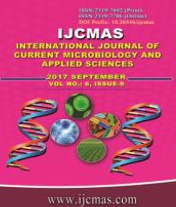


 National Academy of Agricultural Sciences (NAAS)
National Academy of Agricultural Sciences (NAAS)

|
PRINT ISSN : 2319-7692
Online ISSN : 2319-7706 Issues : 12 per year Publisher : Excellent Publishers Email : editorijcmas@gmail.com / submit@ijcmas.com Editor-in-chief: Dr.M.Prakash Index Copernicus ICV 2018: 95.39 NAAS RATING 2020: 5.38 |
A field experiment was conducted at the Oilseed Research Unit, Dr. Panjabrao Deshmukh Krishi Vidyapeeth, Akola during the Rabi season of 2014-15 to study the relative performance of herbicides and cultural practices on weed control in sunflower as well as to study its effect on growth and yield of sunflower. Weed free treatment 3HW at 15, 30 and 45 DAS was found to be the most effective in controlling weeds across the crop growth period. The next best treatment among the herbicidal treatments in respect of controlling weeds was pre-emergence application of Pendimethalin @ 1 kg a.i. ha-1 followed by post emergence spraying of Fenoxoprop ethyl @ 37.5 g a.i. ha-1. Growth parameters and yield attributes of sunflower crop were improved under weed free treatment 3HW at 15, 30 and 45 DAS and treatment pre-emergence application of Pendimethalin @ 1 kg a.i. ha-1 PE followed by Fenoxoprop ethyl @ 37.5 g a.i. ha-1 as PoE. The effect of herbicides on microbial population was observed at initial stage, but it has not caused harmful effect on microbial population at harvesting stage. Total nutrient uptake by crop, highest gross monetary returns (34704 ha-1), net monetary returns (17999 ha-1) and B: C ratio (2.08) were also found highest in treatment weed free 3HW at 15, 30 and 45 DAS.
 |
 |
 |
 |
 |